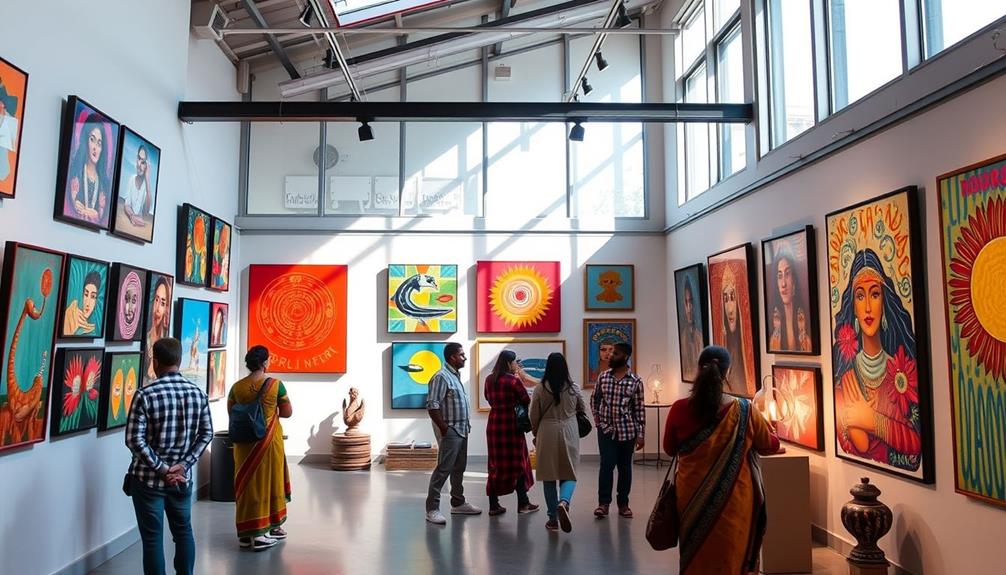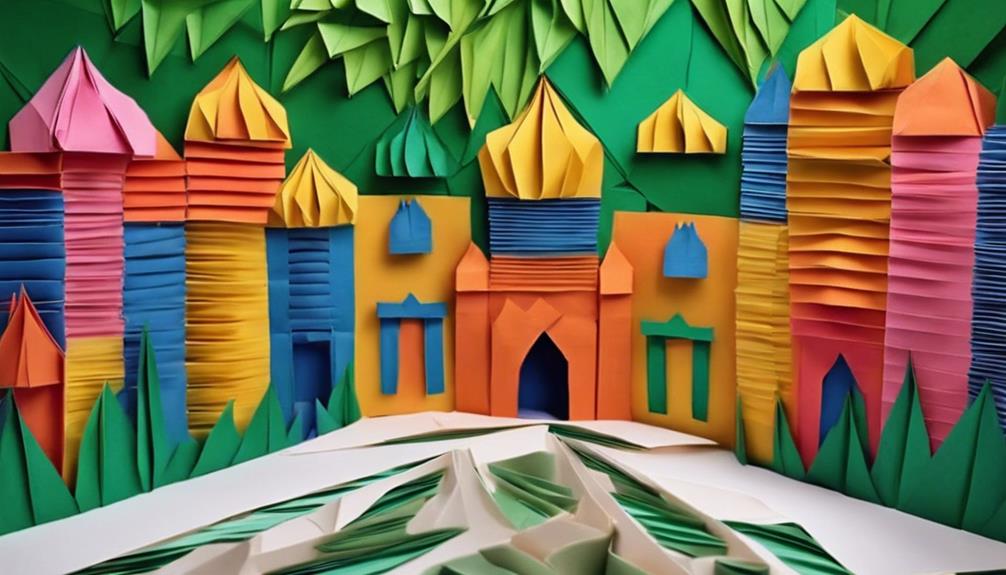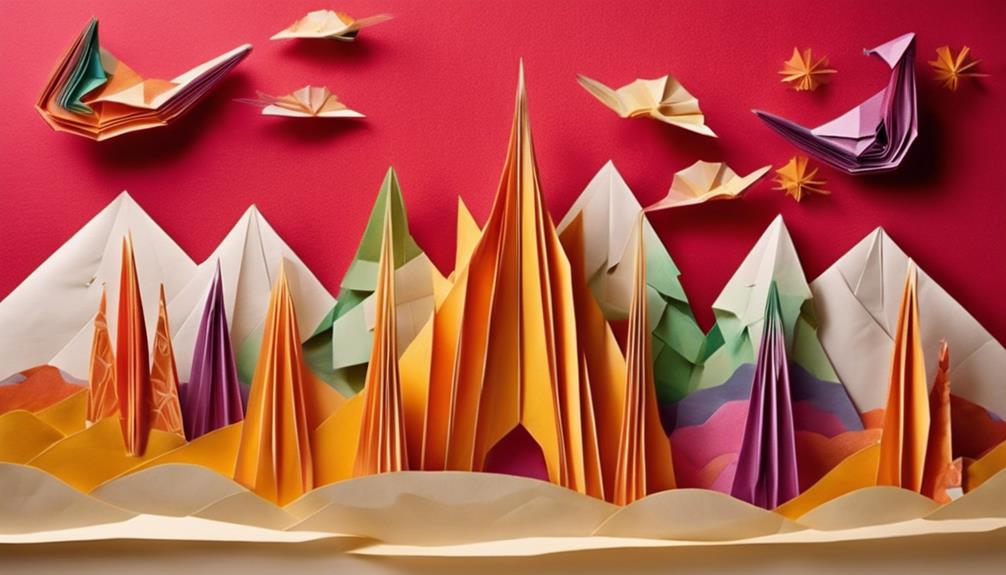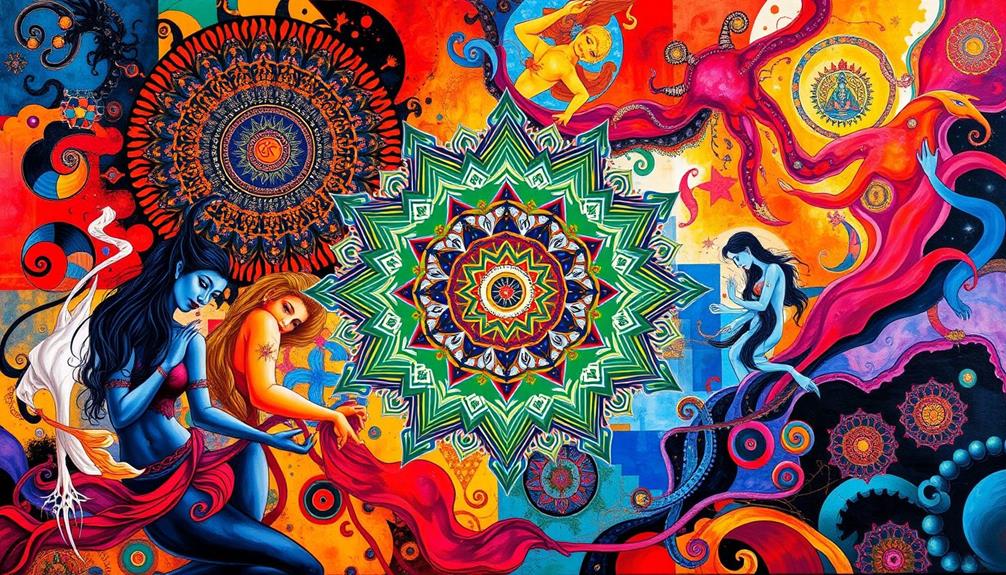Contemporary sculpture in India features a dynamic mix of innovative artists and techniques. You'll find sculptors like Anish Kapoor and Subodh Gupta, who blend traditional forms with modern materials, exploring themes like identity and globalization. Techniques vary widely, from direct carving and casting to assemblage and installation art, utilizing everything from clay to scrap metal. This evolution reflects a rich dialogue about social issues and the environment. As you explore further, you'll uncover how these artists challenge norms and enrich the cultural landscape of India.
Key Takeaways
- Notable Indian sculptors like Ramkinker Baij and Anish Kapoor blend traditional and modern techniques, significantly influencing contemporary art.
- Contemporary sculpture in India utilizes diverse materials, including stone, clay, scrap metal, and innovative mediums like fiberglass and plastic.
- Techniques range from direct carving and casting to assemblage, allowing for complex three-dimensional forms and textures.
- Themes in modern sculpture encompass identity, globalization, social issues, and environmental concerns, reflecting contemporary societal challenges.
- Technological innovations such as 3D printing and sustainable practices are shaping the future of Indian sculpture, enhancing viewer engagement and community involvement.
Notable Indian Sculptors
When exploring the domain of contemporary sculpture in India, you'll encounter a remarkable array of notable sculptors who've shaped the landscape of this art form. One of the pioneers of modern Indian art is Ramkinker Baij, whose piece "The Santhal Family" stands as a landmark in public sculpture. His influence is significant, earning him a Padma Bhushan for his contributions.
Additionally, the evolution of contemporary art can be paralleled with the rise of best animated movies, which often explore profound themes through visual storytelling.
You might also discover Adi Davierwala, a self-taught artist from Mumbai, celebrated for his geometric assemblages that have garnered awards, including first prize at the 1957 State Art Exhibition.
Anish Kapoor, another prominent figure, has achieved fame globally with installations like "Cloud Gate," and his accolades include the prestigious Turner Prize, solidifying his status as one of the most expensive contemporary Indian artists.
Subodh Gupta's work, often composed of everyday objects, investigates the themes of tradition versus globalization, while Piloo Pochkhanwala's innovative use of scrap iron and steel reflects the evolution of contemporary sculpture in India since the 1950s.
These notable Indian sculptors not only reflect the country's rich artistic heritage but also push the boundaries of contemporary Indian sculpture.
Characteristics of Contemporary Sculpture

Contemporary sculpture in India stands out for its unique blend of traditional influences and modernist techniques. As you explore this vibrant art form, you'll notice how artists merge diverse materials, from fiberglass and plastic to scrap iron and everyday objects. This experimentation challenges conventional notions of sculpture while provoking thought about cultural identity and globalization.
You'll also see that installation art plays a significant role in contemporary Indian sculpture. Artists create immersive environments that invite audience participation, fostering a deeper connection between the artwork and its viewers. Themes such as social issues, identity, and spirituality often emerge, reflecting the artists' responses to modern India's socio-political landscape.
Here's a quick overview of the characteristics you'll encounter:
| Characteristics | Description | Examples |
|---|---|---|
| Material Diversity | Use of unconventional materials and mixed media | Scrap iron, plastics |
| Installation Art | Immersive environments that engage viewers | Interactive exhibits |
| Thematic Exploration | Focus on identity, social issues, and spirituality | Reflections of culture |
In this way, contemporary sculpture captures the essence of today's India through its innovative techniques and thought-provoking forms.
Techniques and Materials Used
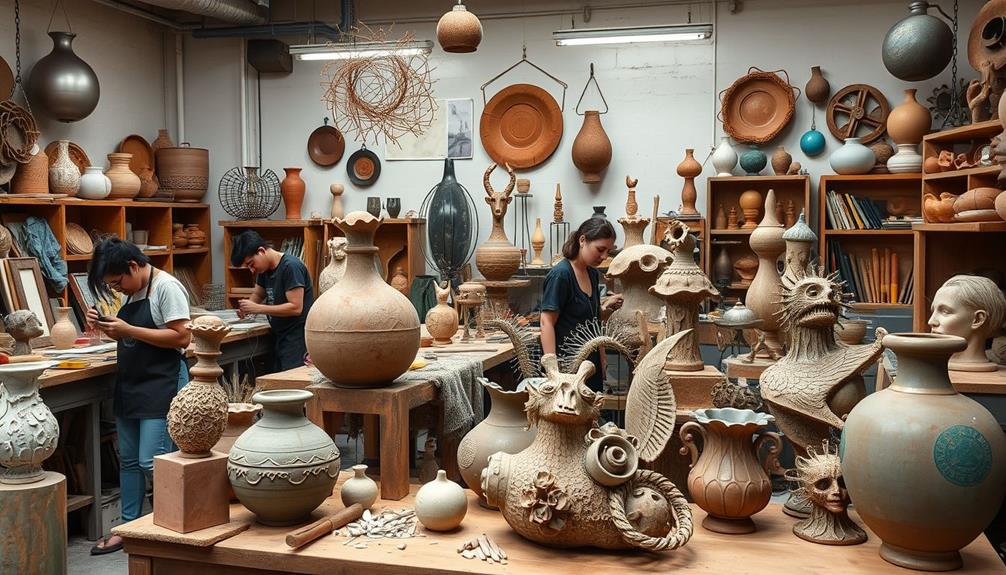
Exploring the techniques and materials used in contemporary Indian sculpture reveals a rich tapestry of creativity and innovation. As a contemporary artist, you'll notice the diverse range of materials at your disposal, from traditional substances like stone and clay to modern mediums such as fiberglass and plastic.
Techniques like direct carving, casting, and assemblage are essential, allowing you to explore three-dimensional forms and textures in your sculptures. The integration of sound design elements can also enhance the viewer's experience, bringing a multi-sensory aspect to your work, reminiscent of AI's impact on traditional music roles.
You might also find inspiration in unconventional materials, such as scrap metal and everyday objects. Artists like Subodh Gupta challenge traditional notions of sculpture, provoking thought about consumerism and globalization through their innovative works.
The rise of installation art encourages you to interact with your surrounding environment, blurring the lines between sculpture and space, as seen in the works of Satish Gujral.
Many sculptors, including Ramkinker Baij and Himmat Shah, have revived ancient techniques like terracotta and bronze casting, skillfully merging them with contemporary themes. This fusion creates unique narratives that resonate with today's audience, enhancing the richness of modern Indian sculpture.
Themes in Modern Sculpture

In modern sculpture, themes of identity, globalization, and social issues dominate the creative landscape, reflecting the complexities of life in today's rapidly changing society. Contemporary Indian artists often grapple with these themes, using their work to explore the tension between traditional values and the influences of globalization. Subodh Gupta, for instance, employs everyday objects to provoke thought about cultural dichotomies and the impact of modernity on local identities. This exploration can mirror the intense emotional experiences often seen in BPD-coded characters, highlighting the struggle between personal identity and societal expectations.
You'll notice a significant shift towards abstract and surrealistic expressions among many sculptors. Artists like Satish Gujral blend figurative elements rooted in Indian culture, conveying emotional depth and a sense of desolation.
Additionally, environmental concerns are increasingly woven into the fabric of modern sculpture, as artists like Sheela Gowda utilize sustainable materials to critique human intervention in nature.
Spiritual and existential themes are also prevalent, with creators like Ramkinker Baij and K.G. Subramanyan using abstract forms to enhance the emotional resonance of their works.
Influential Artists and Their Impact

As you explore the world of contemporary sculpture in India, you'll encounter key artists whose innovative techniques and unique materials have reshaped the landscape.
The emphasis on natural materials and sustainable practices in contemporary art can be likened to the Modern Farmhouse Decor Trends, which also highlight the importance of authenticity in creation.
From Ramkinker Baij's blend of traditional and modern forms to Subodh Gupta's use of everyday objects, each sculptor contributes to a vibrant dialogue about culture and identity.
Their work not only pushes artistic boundaries but also challenges societal norms, making a lasting impact on the art scene.
Key Sculptors' Contributions
Contemporary sculpture in India thrives on the innovative contributions of influential artists who've reshaped the landscape of modern art. Ramkinkar Baij, often hailed as a pioneer of modern Indian sculpture, showcased his vision with works like "The Santhal Family," which symbolizes the essence of public modernist art. His techniques have inspired many contemporary sculptors to explore social themes through their creations.
The influence of cultural backgrounds on artistic expression can be compared to how astrology claims to influence personality traits linked to attractiveness, suggesting that individual experiences shape artistic voices.
Anish Kapoor stands out with his abstract biomorphic forms and polished surfaces, winning international acclaim with iconic pieces like "Cloud Gate." His innovative approach to form and space has made a significant impact on modernist sculpture.
Subodh Gupta utilizes everyday objects such as pots and lunch boxes in large installations, addressing the tension between tradition and globalization in contemporary Indian society.
Additionally, Piloo Pochkhanwala's experimentation with materials like scrap iron and steel has pushed the boundaries of contemporary sculpture, while Adi Davierwala's geometric assemblages reflect a unique intersection of technology and art.
These artists not only enrich the Indian art scene but also influence global perceptions of contemporary sculpture.
Material and Technique Innovations
Innovation in material and technique is at the heart of contemporary sculpture in India, where artists challenge traditional boundaries to create compelling works.
Sculptors like Ramkinker Baij pioneered unconventional materials, merging traditional techniques with modern aesthetics, as seen in his piece "The Santhal Family." In a similar vein, cats exhibit signs of attachment similar to dogs, highlighting the emotional connections that can also be mirrored in artistic expression, cat behavior and emotions.
Adi Davierwala further pushed the envelope by crafting geometric assemblages from wood, stone, and bronze, blending technology with artistic expression.
Piloo Pochkhanwala's shift toward sustainability is notable; his experiments with direct carving and scrap materials emphasize resourcefulness in contemporary practices.
Anish Kapoor's polished surfaces and abstract forms have made a significant impact on global art, epitomized in his iconic installation "Cloud Gate."
Subodh Gupta's use of everyday objects, like pots and lunch boxes, resonates deeply, addressing globalization and cultural identity through innovative material choices.
Each of these artists illustrates how contemporary Indian sculptors are redefining art. Their diverse techniques and materials not only enrich the sculpture landscape but also invite you to reflect on broader themes of innovation, expression, and identity, making their works profoundly relevant today.
Evolution of Artistic Styles
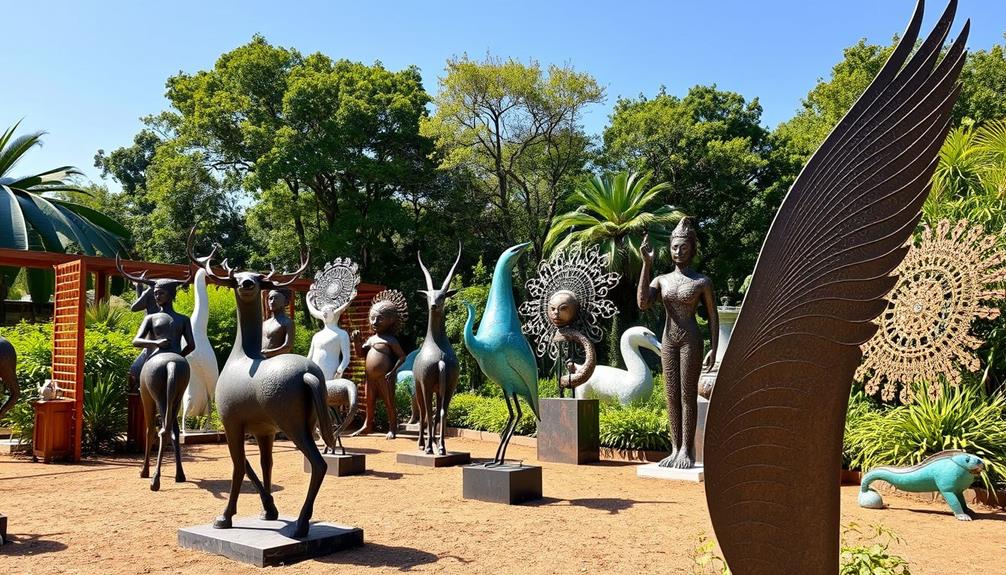
In recent years, the evolution of artistic styles in contemporary Indian sculpture has taken a remarkable turn. You'll notice a significant shift from traditional iconography to a blend of modernist influences, where Indian artists integrate local traditions with global practices. This change reflects a vibrant artistic expression that resonates with today's society.
Particularly, many artists are increasingly emphasizing innovative design and functionality in their works, mirroring trends seen in architecture and other creative fields.
During the post-independence period, sculptors like Ramkinker Baij and Piloo Pochkhanwala experimented with unconventional materials, paving the way for more abstract and expressive forms. The use of diverse materials, including fiberglass, plastic, and mixed media, has become commonplace, resulting in innovative installations that engage with their surroundings in unique ways.
Influential figures like Anish Kapoor and Subodh Gupta have led the charge in installation art, highlighting the connection between space, viewer interaction, and cultural identity.
As you explore contemporary sculpture in India, you'll find that themes often address pressing social, political, and environmental issues, mirroring the complexities of globalization and identity. This evolution showcases how Indian artists are redefining their craft while remaining rooted in a rich cultural heritage.
The Future of Indian Sculpture
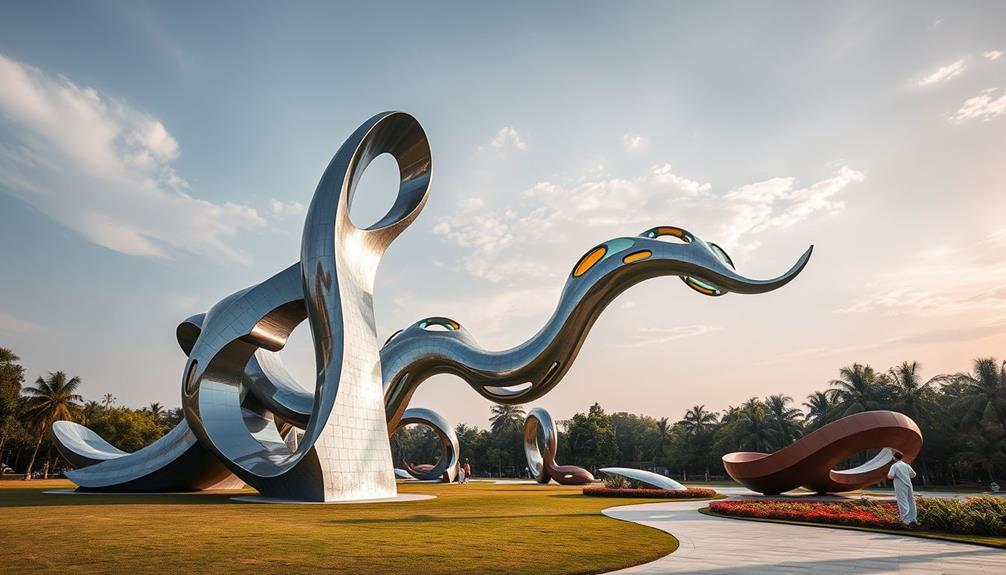
As you explore the future of Indian sculpture, you'll notice a wave of emerging artists pushing boundaries with innovative styles and techniques.
They're harnessing technological advancements to create interactive pieces that resonate with audiences in new ways.
This evolution mirrors trends seen in other fields, such as how AI transformations in healthcare improve accuracy and personalization.
This fusion of tradition and modernity not only enriches the art form but also reflects the evolving cultural landscape of India.
Emerging Artists and Styles
There's a vibrant wave of emerging artists in India reshaping the landscape of contemporary sculpture. These innovative creators are pushing boundaries by using unconventional materials like recycled objects, clay, and found materials, much like the philosophies discussed in classic philosophical texts for beginners.
Their work reflects pressing themes of migration, identity, and environmental concerns, inviting you to engage in dialogue about globalization and cultural heritage.
- Feel the urgency of environmental issues through their art.
- Witness the fusion of traditional craftsmanship and modern techniques.
- Experience community spirit through collaborative public installations.
- Discover the stories of diverse identities that shape our world.
As these emerging artists adopt interdisciplinary approaches, they often collaborate with architects and designers to create public installations that not only enhance urban spaces but also foster community engagement.
The rise of art fairs, like the Kochi Biennale, is essential, giving these sculptors a platform to shine and connect with international audiences.
This dynamic environment promises an exciting future for Indian sculpture, where you can anticipate fresh perspectives and innovative styles that challenge conventional norms and spark meaningful conversations.
Technological Innovations in Sculpture
With the rise of technological innovations, Indian sculpture is entering an exciting new era. Artists are now using 3D printing and digital modeling to create intricate designs that traditional methods couldn't achieve. This advancement allows for more creativity and precision, pushing the boundaries of what's possible in sculpture.
Additionally, the importance of maintaining clear energy pathways for health can inspire artists to channel positive energy into their creations, enhancing the overall impact of their work energy pathways for health.
You'll also notice that many sculptors are integrating augmented reality (AR) and virtual reality (VR) into their installations. This not only enhances viewer engagement but also offers immersive experiences that blend the physical and digital domains, making art more interactive than ever.
Moreover, the movement towards sustainable materials and eco-friendly practices is gaining momentum. Artists are increasingly using recycled and biodegradable substances to address environmental concerns, ensuring that their art contributes positively to the planet.
Collaborations between sculptors and technologists are fostering remarkable innovations, incorporating kinetic elements and soundscapes into sculptures. These dynamic and interactive art pieces captivate audiences, inviting them to experience art in new ways.
As sculptors leverage social media and online galleries to showcase their work, the future of Indian sculpture promises to be vibrant, accessible, and deeply engaging.
Frequently Asked Questions
What Are the Techniques Used in Contemporary Sculpting?
In contemporary sculpting, you'll explore techniques like direct carving, welding, and casting. You might also experiment with mixed media approaches, combining traditional methods with modern technologies to create innovative, engaging forms that resonate with viewers.
Who Is the Famous Sculpture Artist in India?
When you think of famous sculpture artists in India, you can't overlook Ramkinker Baij, Anish Kapoor, and Subodh Gupta. Their innovative styles and impactful works have truly shaped the landscape of Indian sculpture.
What Is an Example of a Modern Indian Sculpture?
One example of a modern Indian sculpture is Ramkinker Baij's "Santhal Family." Created in 1937, it beautifully captures themes of migration and familial bonds, making it a significant piece in India's artistic landscape.
Who Are the Sculptors of Modern India?
You'll find sculptors like Ramkinker Baij, Anish Kapoor, and Subodh Gupta shaping modern India's art scene. Each artist brings unique techniques and perspectives, reflecting the country's rich cultural heritage and contemporary issues through their works.
Conclusion
In the vibrant world of contemporary Indian sculpture, you see a clash of tradition and innovation, where ancient techniques meet modern materials. As artists push boundaries, they breathe life into stone and metal, transforming them into powerful narratives. The future promises even more evolution, blending diverse influences while honoring rich heritage. Whether you're drawn to bold forms or subtle messages, the dynamic landscape of Indian sculpture invites you to explore, reflect, and connect with the ever-changing artistic dialogue.

